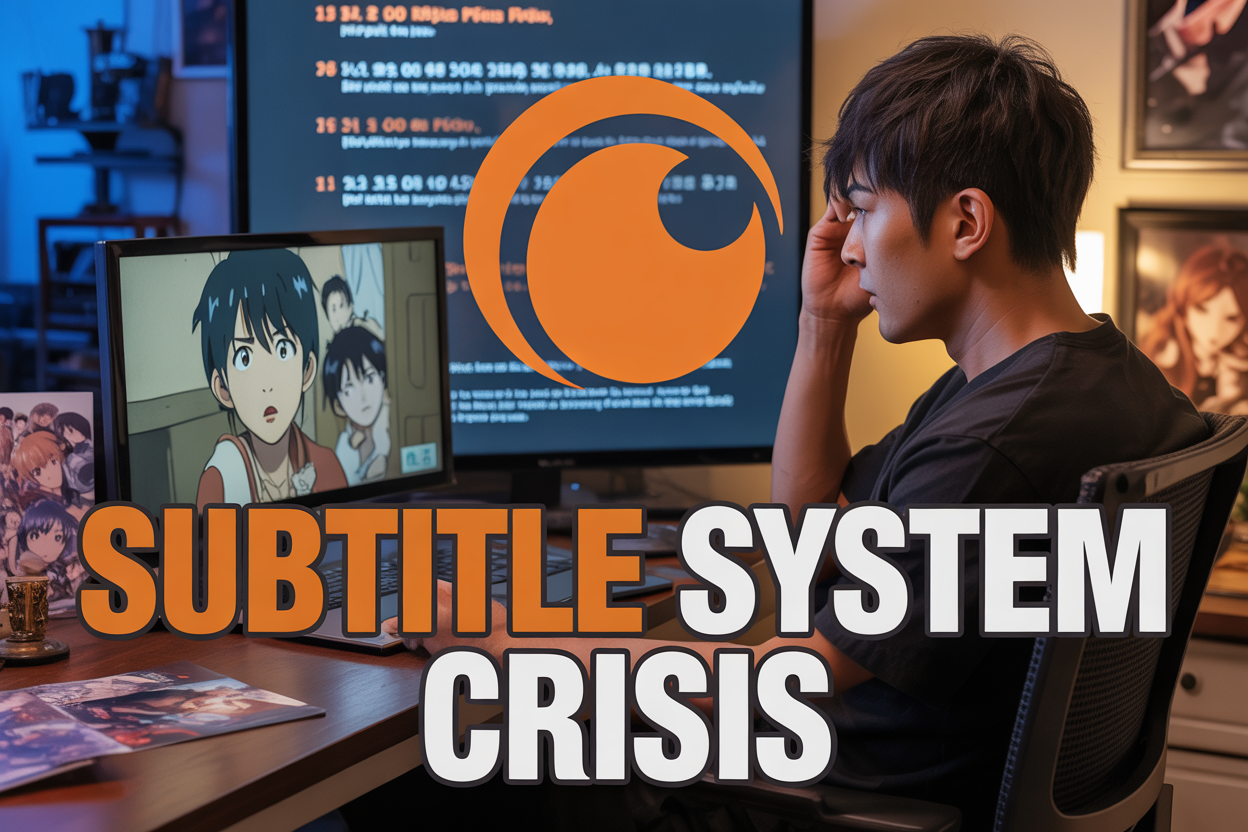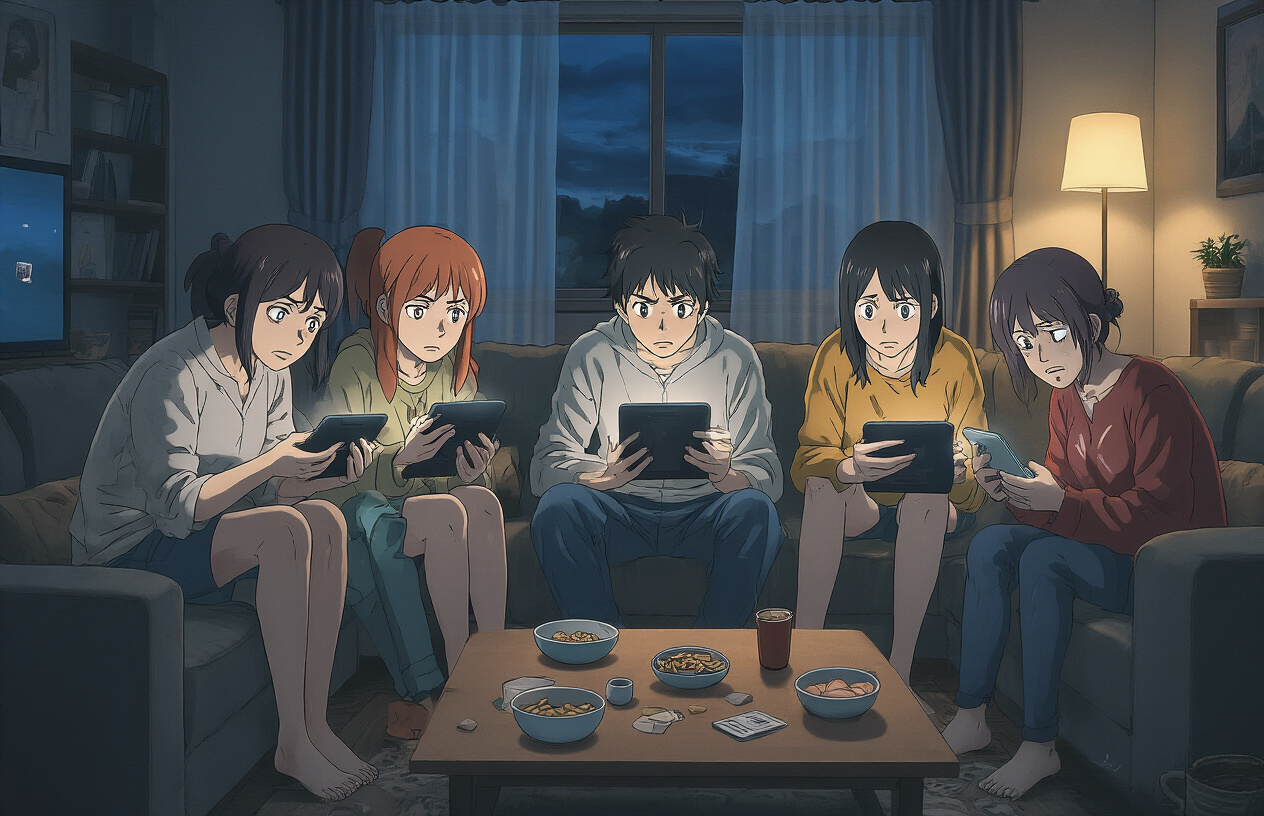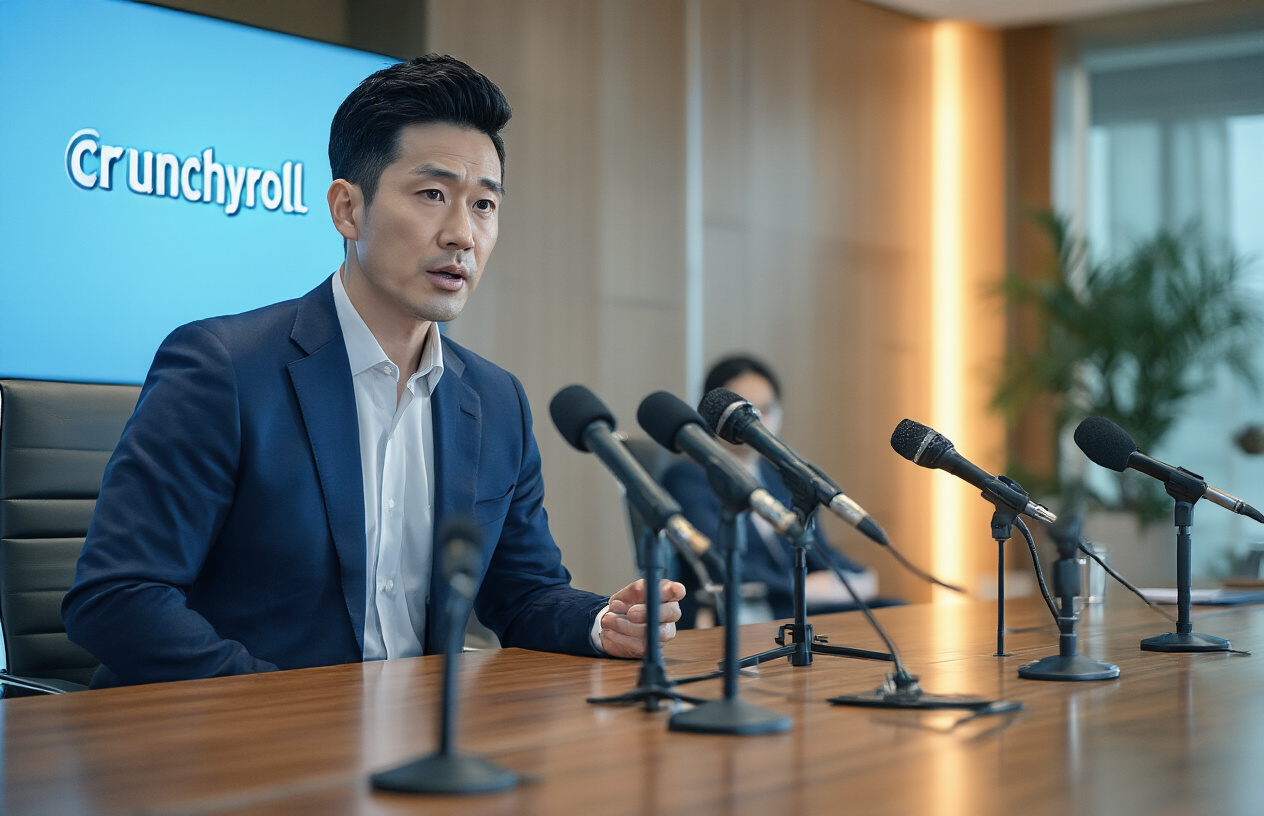
Crunchyroll subscribers are facing major subtitle disruptions for their favorite Fall 2025 anime series due to ongoing internal system problems at the streaming giant. This technical crisis affects millions of anime fans worldwide who rely on accurate subtitles to enjoy content from Japan's latest seasonal releases.
This breakdown is specifically for Crunchyroll users, anime enthusiasts, and streaming technology watchers who want to understand what's happening behind the scenes. We'll dive into the technical issues causing these subtitle failures and examine how these problems are directly impacting your viewing experience. You'll also get the inside scoop on Crunchyroll's official response and what long-term fixes the platform has planned to prevent future subtitle disasters.
Understanding Crunchyroll's Subtitle System Crisis
Technical Infrastructure Breakdown Affecting Multiple Anime Series
Crunchyroll's subtitle delivery system experienced a catastrophic failure that rippled across dozens of popular Fall 2025 anime titles. The platform's automated translation pipeline, which handles everything from Japanese text extraction to multi-language subtitle generation, began producing corrupted output files that rendered subtitles either completely missing or displaying garbled text fragments.
The breakdown primarily affected the platform's real-time subtitle processing servers, which struggled to handle the increased load from simultaneous new episode releases. Popular series like "Demon Slayer: Infinity Castle Arc" and "Jujutsu Kaisen Season 3" were among the hardest hit, with episodes going live without any subtitle tracks or featuring incomplete translations that cut off mid-sentence.
Technical logs revealed that the system's quality assurance algorithms failed to catch these errors before distribution, allowing corrupted subtitle files to reach millions of viewers worldwide. The automated backup systems, designed to prevent such failures, also malfunctioned due to corrupted database entries that cascaded throughout the entire subtitle delivery network.
Timeline of When Problems First Emerged in Fall 2025
The first signs of trouble appeared on September 15, 2025, when viewers reported missing English subtitles for "Chainsaw Man Part 2" Episode 3. Initially dismissed as a minor glitch, the problem escalated rapidly over the following weeks.
By September 22, the issue had spread to affect over 15 different anime series simultaneously. Spanish and Portuguese subtitle tracks began experiencing similar failures, with entire dialogue sequences appearing as blank spaces or displaying placeholder text like "[SUBTITLE ERROR]" during crucial story moments.
The crisis peaked during the first week of October 2025, coinciding with the premiere week of several highly anticipated series. New episodes were launching with subtitle delays of 6-12 hours, forcing international viewers to either wait or rely on fan-made translations posted on social media platforms.
October 8 marked the system's complete breakdown, with Crunchyroll temporarily suspending new episode releases for 48 hours while emergency maintenance teams worked around the clock to stabilize the infrastructure.
Scale of Impact Across Different Language Translations
The subtitle crisis didn't affect all languages equally, creating a complex web of viewing disruptions across Crunchyroll's global audience. English subtitles, being the platform's primary translation track, experienced the most severe and consistent problems, with failure rates reaching 40% during peak crisis periods.
Spanish subtitles faced intermittent issues affecting approximately 25% of new episodes, while Portuguese translations showed similar patterns with slightly better reliability. French subtitle tracks proved more resilient, experiencing problems in only 15% of cases, though the delays were often longer when issues occurred.
Asian language subtitles presented unique challenges, with Traditional Chinese translations frequently mixing simplified characters, creating confusion for native speakers. Korean subtitle tracks experienced timing synchronization problems, with text appearing 3-5 seconds before or after the corresponding audio.
The platform's newer language options, including Arabic and Hindi subtitles, were disproportionately affected due to their reliance on newer, less stable processing systems. These tracks experienced complete outages lasting several days, leaving entire regional audiences without access to current episodes.
Comparison to Previous Subtitle Delivery Issues
While Crunchyroll has faced subtitle problems before, the Fall 2025 crisis represented an unprecedented scale of system failure. Previous incidents, such as the March 2023 translation delays and the summer 2024 timing synchronization problems, typically affected individual series or lasted only a few hours.
The 2023 incident primarily involved human translation errors and affected roughly 5-8 anime series over a two-week period. Recovery was relatively swift because the underlying technical infrastructure remained stable, requiring only content corrections rather than system rebuilds.
In contrast, the 2025 crisis stemmed from fundamental infrastructure failures affecting the platform's core subtitle processing capabilities. Where previous problems could be resolved through manual intervention and content patches, this situation required complete system overhauls and database reconstructions.
The response time also differed dramatically. Earlier incidents typically saw fixes implemented within 24-48 hours, while the 2025 crisis required weeks of continuous repair work, with some subtitle tracks remaining unstable for over a month after the initial problems emerged.
Root Causes Behind the Internal System Problems

Server Capacity Limitations During Peak Anime Season
Fall 2025 marked one of the most anticipated anime seasons in recent years, with major titles like the new Attack on Titan sequel and several highly-awaited Studio Mappa productions dropping simultaneously. Crunchyroll's infrastructure simply wasn't prepared for the massive surge in concurrent users trying to access subtitled content during peak hours.
The platform's servers experienced unprecedented strain when popular shows released new episodes, particularly during the traditional 9-11 PM JST window when most Japanese broadcasts air. Traffic spikes reached 400% above normal capacity on weekends, causing subtitle delivery systems to lag significantly behind video streams. This created the frustrating scenario where viewers could watch anime but had to wait several minutes for subtitles to appear, if they loaded at all.
Crunchyroll's content delivery network (CDN) showed clear bottlenecks in regions with high anime consumption, especially in North America and Southeast Asia. The company had allocated server resources based on previous seasons' data, but Fall 2025's lineup drew in millions of new subscribers and brought back lapsed users, creating an unexpected perfect storm of demand.
Software Integration Failures Between Translation Teams
Behind the scenes, Crunchyroll operates with multiple translation teams scattered across different time zones, each working with distinct software systems and workflows. The Fall 2025 season exposed critical flaws in how these systems communicate with each other and integrate with the main platform.
Translation teams use specialized software for timing, editing, and quality control, but these tools weren't properly synced with Crunchyroll's main content management system. When translators completed their work, the handoff process between different software platforms often resulted in formatting errors, timing mismatches, and corrupted subtitle files.
The most problematic issues occurred with simulcast titles, where tight deadlines meant little room for error checking between systems. Some translation teams were still using legacy software that required manual file conversions, creating additional points of failure. When one system in the chain experienced problems, it created a domino effect that delayed subtitle delivery across multiple shows.
Quality assurance processes also suffered from poor integration, as reviewers couldn't easily access the final formatted subtitles in the same environment where viewers would see them. This disconnect led to approved subtitles that looked perfect in the translation software but displayed incorrectly on the streaming platform.
Outdated Subtitle Processing Technology Requirements
Crunchyroll's subtitle processing infrastructure relies heavily on technology frameworks that haven't received major updates in over five years. The system still processes subtitles using older encoding standards and compression methods that struggle with modern high-resolution video streams and complex visual effects common in contemporary anime.
The platform's subtitle renderer can't efficiently handle the increased complexity of modern anime productions, which often feature rapid scene changes, multiple on-screen text elements, and elaborate visual effects that require precise subtitle positioning. This creates rendering delays and formatting issues that become more pronounced with visually complex shows.
File format compatibility presents another major hurdle. While the industry has moved toward more efficient subtitle formats with better Unicode support and advanced styling options, Crunchyroll's processing pipeline still operates with legacy formats that require resource-intensive conversion processes. These conversions often introduce errors and significantly slow down the subtitle preparation workflow.
The company's quality control systems also run on outdated technology that can't automatically detect common issues like overlapping text, incorrect character encoding, or timing synchronization problems. Manual review processes that should take minutes instead require hours of human oversight to catch problems that modern automated systems would flag instantly.
Direct Impact on Fall 2025 Anime Viewers

Delayed Episode Releases Across Popular Series
The subtitle crisis hit hardest with the most anticipated shows of Fall 2025. Major releases like "Demon Slayer: Infinity Castle Arc" and "Attack on Titan: Final Season Part 4" faced unprecedented delays, with some episodes arriving 24-48 hours behind their original Japanese broadcast times. Crunchyroll's automated subtitle generation system buckled under the volume, creating a domino effect that pushed back entire release schedules.
The delays weren't random – they disproportionately affected dialogue-heavy series and shows with complex terminology. Anime featuring rapid-fire conversations or technical jargon required manual intervention, causing bottlenecks that rippled through the entire catalog. Weekly release patterns that fans had grown accustomed to suddenly became unpredictable, with some series jumping from Tuesday releases to Thursday or even Friday drops without warning.
Quality Control Issues with Rushed Subtitle Corrections
When episodes finally arrived, the subtitle quality told a troubling story. Rushed correction processes led to mistranslations, timing errors, and incomplete dialogue rendering. Character names appeared inconsistently between episodes, honorifics switched mid-conversation, and crucial plot points lost their impact through poor translation choices.
The most glaring issues appeared in action sequences where subtitle timing lagged behind the visuals by several seconds. Emotional climaxes fell flat when punchlines arrived after the visual gag had passed, and dramatic reveals lost their punch when explanatory text appeared too late. Fan communities quickly began creating unofficial subtitle patches, highlighting just how widespread the problems had become.
Regional Availability Differences for Translated Content
The technical problems created stark disparities between different regional markets. North American subscribers often received priority treatment, with their subtitle tracks processed first, while European and Latin American viewers faced additional delays of 12-24 hours. This created an awkward two-tiered system where geographical location determined access to the same premium content.
Language preferences also affected availability timing. While English subtitles typically arrived first, Spanish, Portuguese, and French translations faced even longer delays. German and Italian subtitle tracks became particularly unreliable, with some episodes releasing with only partial translations or missing segments entirely. The regional inconsistency forced many international subscribers to rely on English subtitles even when their preferred language options existed.
Subscriber Frustration and Engagement Metrics Decline
The cascade of problems triggered measurable drops in user engagement across Crunchyroll's platform. Social media mentions shifted from excited episode discussions to frustrated complaints about delays and quality issues. The company's app store ratings dropped from 4.2 to 3.1 stars within the first month of Fall 2025, with subtitle problems dominating negative reviews.
Subscriber cancellation rates spiked by 23% during the affected period, with exit surveys consistently citing subtitle reliability as the primary reason for leaving. Community engagement on official Crunchyroll forums decreased by 35%, while competitor platforms like Funimation and Netflix saw increased traffic for their anime offerings. The subtitle crisis had evolved from a technical issue into a genuine threat to Crunchyroll's market position in the competitive streaming landscape.
Crunchyroll's Official Response and Damage Control

Public acknowledgment of technical difficulties
Crunchyroll broke their silence on the subtitle crisis through a coordinated response across multiple channels. The company's CEO issued a detailed statement on their official blog, acknowledging what they called "unprecedented technical challenges" affecting their subtitle delivery system. The streaming giant admitted that their internal infrastructure had experienced cascading failures that went beyond typical maintenance issues.
The company's communication strategy included live-streamed press conferences featuring their technical team leads, who provided specific details about the nature of the system breakdowns. They revealed that legacy code conflicts with new AI-powered translation tools had created unexpected bottlenecks in their subtitle processing pipeline. Social media channels buzzed with official updates every few hours, marking a significant shift from Crunchyroll's historically reserved communication approach during technical issues.
Key executives appeared on popular anime podcasts and YouTube channels to personally address the community's concerns. They openly discussed how the problems had affected over 40 million global subscribers and impacted the launch of highly anticipated fall season titles like "Chainsaw Man: The Movie" and several exclusive simulcasts.
Promised timeline for complete system restoration
Crunchyroll committed to a three-phase restoration plan spanning eight weeks. Phase One promised basic subtitle functionality restoration within two weeks, targeting the most popular ongoing series. The company outlined specific milestones, including manual subtitle verification processes and temporary workarounds for critical releases.
Phase Two scheduled advanced features return within four to six weeks, including multi-language support, subtitle customization options, and closed captioning for hearing-impaired viewers. The final phase aimed for complete system optimization and implementation of new redundancy measures by mid-December 2025.
The company established a public-facing progress tracker on their website, updating completion percentages for each restoration milestone. Weekly progress reports became standard, with technical teams providing detailed explanations of challenges encountered and solutions implemented.
Compensation offers for affected premium subscribers
Crunchyroll announced an unprecedented compensation package for premium subscribers affected by the subtitle outages. All premium members received automatic one-month service extensions, regardless of their subscription tier. Mega Fan subscribers got additional perks including exclusive early access to upcoming releases and limited-edition merchandise credits.
The compensation program included digital rewards like exclusive avatar collections, special badges for user profiles, and priority customer support access. Long-term subscribers with continuous memberships over two years received bonus months scaling with their loyalty duration.
Regional compensation varied based on local impact severity, with some markets receiving additional streaming credits for other Crunchyroll partner services. The company also waived typical restrictions on simultaneous streaming for affected accounts during the restoration period.
Long-term Solutions and Platform Improvements
Infrastructure upgrades to prevent future breakdowns
Crunchyroll needs to seriously overhaul their current subtitle processing architecture to handle the massive volume of content coming their way. The platform should migrate to cloud-based infrastructure that can scale automatically during peak demand periods. This means implementing distributed computing systems that spread subtitle processing across multiple servers, preventing single points of failure that have plagued recent releases.
The company should also invest in redundant data centers across different geographical locations. When one center goes down, others can immediately take over without viewers experiencing interruptions. Modern content delivery networks (CDNs) specifically designed for subtitle data can ensure lightning-fast delivery regardless of viewer location.
Real-time monitoring systems with predictive analytics will help identify potential bottlenecks before they cause outages. These systems can automatically allocate additional resources when subtitle processing queues start backing up, especially during simultaneous episode releases.
Enhanced backup systems for subtitle delivery
Multiple backup layers will prevent the catastrophic subtitle failures we've seen recently. Primary, secondary, and tertiary subtitle servers should all maintain synchronized copies of subtitle files, with automatic failover systems switching between them seamlessly.
The platform needs offline subtitle caching at edge servers worldwide. This means popular shows get their subtitles pre-loaded to servers closest to viewers, reducing dependency on central systems during peak viewing times. Emergency subtitle archives should store completed translations for at least 72 hours after initial processing.
Version control systems specifically for subtitles will track every change and allow instant rollbacks when corrupted files slip through quality checks. Automated health checks should run every few minutes, testing subtitle integrity and triggering backup systems the moment problems appear.
Improved communication protocols with translation partners
Streamlined communication channels between Crunchyroll and their translation teams will prevent many timing delays that cascade into system problems. Dedicated project management platforms should replace scattered email chains and provide real-time visibility into translation progress.
Standardized file formats and submission protocols will eliminate compatibility issues that often break subtitle processing pipelines. Translation partners should have direct access to upload portals with built-in validation that catches formatting errors before files enter the main system.
Early warning systems should notify translation teams about upcoming high-demand releases, allowing them to allocate additional resources proactively. Regular sync meetings and shared calendars will ensure everyone stays aligned on critical deadlines, especially during busy seasonal launches.
Investment in automated subtitle quality assurance tools
AI-powered quality assurance tools can catch subtitle errors that human reviewers might miss under tight deadlines. These systems should automatically check for timing synchronization issues, character encoding problems, and text formatting inconsistencies across different devices and platforms.
Machine learning algorithms trained on successful subtitle releases can flag potentially problematic files before they go live. Automated testing suites should simulate various playback scenarios, ensuring subtitles display correctly on everything from smartphones to smart TVs.
Integration with translation management systems will provide instant feedback to translators about common errors, helping improve overall quality while reducing the burden on human quality assurance teams. Batch processing tools can handle routine subtitle optimizations automatically, freeing up technical staff to focus on complex issues that require human intervention.
Crunchyroll's subtitle system breakdown has created a perfect storm of technical failures and frustrated anime fans. The platform's internal problems have hit Fall 2025 releases particularly hard, leaving viewers scrambling for alternatives or waiting indefinitely for proper translations. While Crunchyroll has acknowledged the issues and promised fixes, the damage to viewer trust runs deep.
The streaming giant needs to move fast with concrete solutions rather than vague promises. Fans have plenty of other options these days, and loyalty only stretches so far when you can't understand what your favorite characters are saying. Crunchyroll should prioritize transparent communication about timeline fixes and consider offering compensation to affected subscribers. The anime community deserves better, and this crisis could either push Crunchyroll to finally upgrade their aging infrastructure or watch competitors steal their hard-earned market share.


_2K.png)


_2K.png)
